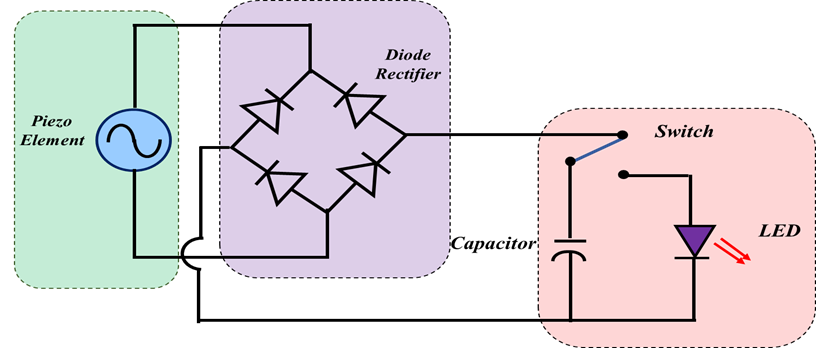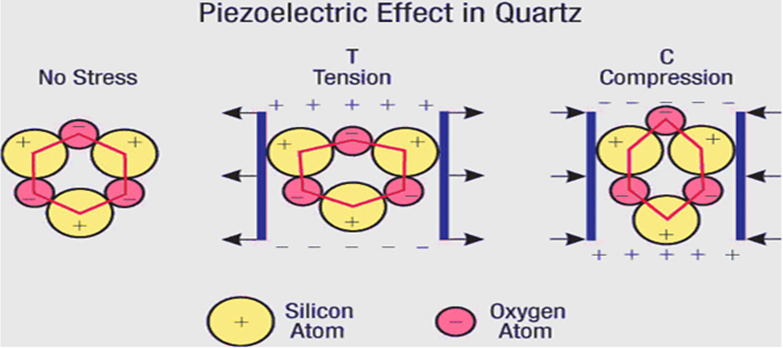Piezoelectric Generator
01/12/2021, hardwarebee
A piezoelectric generator is basically a type of generator that converts one form of energy to another form. The generator converts mechanical energy into electricity and has a vast application in modern day life.
Working principle
It is an important and innovative method of generation of electric energy from mechanical energy without the need of rotational effect of generators. Therefore, piezoelectric generator provides the method of direct conversion of electric energy to mechanical energy without typical movement in rotation. Therefore, it has no moving parts that makes it easy to use, compact and reliable as well. In addition, these features make conditioning of the signal easier in piezoelectric generator.

Figure 1: Diagram to represent working of piezoelectric generator [1]
The mechanism of piezoelectric generators involves electric dipoles generation and the operation of piezoelectric generation is based on it. Dipole is basically two opposite charges that have small distance as separation like bar magnet. If force is applied on piezoelectric material, there is a minor change in the structure of crystal that induces the dipole formation. Therefore, voltage is appeared on the crystal faces an it provides small amount of charge. The extracted voltage could be used to charge the battery or power some sort of electric circuit. The reverse of the entire process is also possible and it is applied in piezo buzzers and ultrasonic transducers.

Figure 2: Piezoelectric generation circuit diagram [2]
Quartz is a crystalline form of the compound silicon dioxide and it could be used as a good example of piezoelectric material.

Figure 3: Piezoelectric generation concept in Quartz [4]
Daily life Applications
Piezoelectric generators are used in push button cigarette lighters and gas BBQ grills as well. They used a spring-loaded hammer that could apply mechanical energy to piezoelectric material and that energy is collected.
Types of Piezoelectric Generators
Single Layer Piezoelectric Generators
This type of piezoelectric generators is small and simple, long lasting and require little maintenance. Examples of ingle layered piezoelectric generators is crystal piezoelectric generators.
Multilayer Piezoelectric Generators
There are different number of layers in this type of piezoelectric generators therefore, the output current level is significantly higher than single layered piezoelectric generators. Examples of multilayer piezo generators are energy sources for munitions and wireless sensors, such as sensors that monitor tire pressure in automobiles.
Piezoelectric Energy Harvesting
Piezoelectric generators are being designed for large scale energy harvesting but it has many constraints. Piezoelectric ceramics have limited energy outputs, and therefore are potentially cost prohibitive to feasibly use in any large-scale energy harvesting application.
Energy Harvesting with Piezoelectric Sensors
Although piezoelectric generators could not generate enough electricity but in automotive industry it could be applied to extract the maximum amount of output energy so that power could be saved. In cases if piezoelectric generators could operate some of the sensors that require little inputs, it would be a great contribution in automotive and aeronautical industries because at least that particular element would no longer extract power from the main energy source.
Common Piezoelectric Materials
Piezoelectric materials are categorized as naturally occurring and artificially occurring elements. Some good examples of piezoelectric elements are stated below:
Naturally Occurring Materials
Quartz, Rochelle salt (Potassium Sodium tartarate) and Sucrose
Artificially Occurring Materials
Ceramics, Zinc Oxide, Barium titanate, and Lead zirconate titanate.
Power Produced by Piezo Generators
Maximum power that is generated by piezoelectric generators is nearly 2mW, and could be used for charging of 40mAh button cell battery in one hour. Therefore, piezoelectric materials could be applied in transducers to interchange electrical energy and mechanical force.
Efficiency of Piezo Generators
Piezoelectric generators convert mechanical power to electrical power and has the conversion efficiency 37%.
Piezoelectric Generators – Benefits and Limitations
Advantages of piezoelectric generators
- Piezoelectric generators have small size and are versatile because of their flat and flexible shape.
- Piezoelectric generators could be used to extract little energy for example if the sensor is used in footwear, the step compression could be used to generate electricity. The energy that would be extracted would be used to charge light or cellphone battery in emergency.
- Piezoelectric generators are very useful to extract the waste energy like energy from vibrations or small sources.
- Piezoelectric generator provides the method of direct conversion of electric energy to mechanical energy without typical movement in rotation so its compact and reliable as well.
Disadvantages
- Piezoelectric generators could be used to extract limited power only. If continuous energy output is to be extracted from piezoelectric generators, there is a need of putting the piezoelectric element to vibrations and the extracted power is AC. Therefore, only limited voltage could be converted to usable AC voltage.
- Piezoelectric materials could not be used for static measurement and have temperature sensitivity.
Considering all these aspects, it is easier to use piezoelectric generators for industrial environments that have a lot of mechanical vibrations for operating small IoT microcontrollers used for monitoring purposes.
Conclusions
It could be concluded that Piezoelectric generators apply the piezoelectric effect and performs the conversion mechanical energy into electrical energy. Piezoelectric generator provides the method of direct conversion of electric energy to mechanical energy without typical movement in rotation. Therefore, it has no moving parts that makes it easy to use, compact and reliable as well. As, the output power from piezoelectric generator is lower, it finds application in providing electric power to low current sensors from sources of mechanical vibration. It provides a method of harvesting the energy that is considered as wasted energy.
References:
[1] Elvin, N. G., & Elvin, A. A. (2009). A general equivalent circuit model for piezoelectric generators. Journal of Intelligent Material Systems and Structures, 20(1), 3-9.
[2] Kokkinopoulos, A., Vokas, G., & Papageorgas, P. (2014). Energy harvesting implementing embedded piezoelectric generators–The potential for the Attiki Odos traffic grid. Energy Procedia, 50, 1070-1085.
[3] Hu, C. J., Lin, Y. H., Tang, C. W., Tsai, M. Y., Hsu, W. K., & Kuo, H. F. (2011). ZnO‐coated carbon nanotubes: flexible piezoelectric generators. Advanced Materials, 23(26), 2941-2945.
[4] Khaligh, A., Zeng, P., & Zheng, C. (2009). Kinetic energy harvesting using piezoelectric and electromagnetic technologies—state of the art. IEEE transactions on industrial electronics, 57(3), 850-860.
[5] Cao, Z., Zhang, J., & Kuwano, H. (2012). Design and characterization of miniature piezoelectric generators with low resonant frequency. Sensors and Actuators A: Physical, 179, 178-184.











